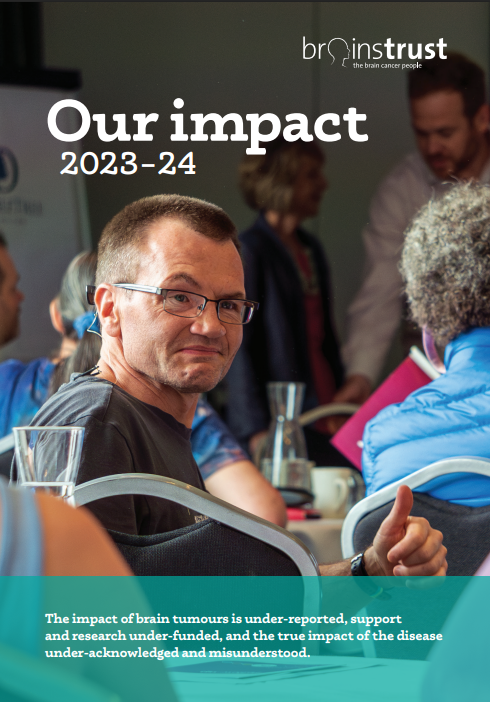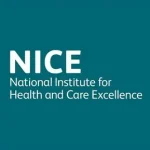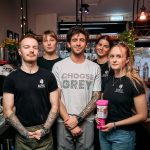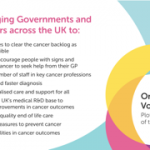Meet 11 year old Freya living with the affects of a childhood brain tumour
So, with the diagnosis of a brain tumour on 5th March 2020 our worlds were turned upside down and everything moved very quickly and urgently with the 13th March 2020 being the day Freya had surgery to decompress the cyst and partially remove the tumour. The tumour was identified as a Ganglioglioma WHO low grade 1. – Nicola (Freya’s mum).
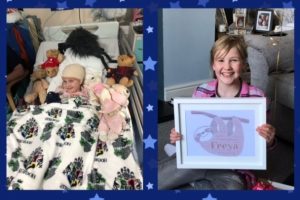
Signs and symptoms
A brain tumour can cause symptoms by pushing on the brain or blocking fluid getting to the brain. Sometimes the brain tumour pushes on parts of the brain that control certain body functions. Therefore, the signs and symptoms of each brain tumour is dependent on the size and location of the tumour.
For Freya, her tumour was causing weakness in her right arm and was affecting her walking. Nicola recalls:
Freya’s symptoms were identified by her ballet teacher in a private lesson when her right arm started to dither in certain positions and she had difficultly lifting her arm up high. At around the same time, Freya noted difficultly writing as her right hand would shake and her writing became shaky and wobbly. She even explained that once she lost the grip of her pencil and dropped it without knowing.
With a visit to the GP followed by an urgent referral to the local hospital for bloods and an MRI, a cyst and tumour were identified and we were rushed to Birmingham Children’s Hospital in an ambulance. Whilst there her symptoms got worse and Freya’s walking began to be effected with her right ankle starting to flick out and she began to drag her toes misjudging the floor. This progressively got worse over a few days and we later learnt It was the cyst pressing on her nerves.
Life after surgery
Freya’s tumour required no further treatment and her recent scan showed there is some residual tumour which the hospital will closely monitor. The hope is that this residual tumour will not grow and turn into scar tissue.
Following treatment, brain tumours can leave late effects for children and young people due to the impact to the brain. For Freya the tumour has left weakness in her right arm, but her walking is improving and she now runs better than she can walk! Another aspect Freya is really struggling with her fatigue which affects her at school.
Freya has unfortunately been left with a weaker right arm and hand and doesn’t like using it and does choose to ignore it. She has learnt how to right very well with her left and doesn’t see point of trying to use the right. We constantly have to remind her to use it. It has gained some strength and can grip a pencil but writing is not comfortable and more difficult. Her right leg worsened with effects from the operation but extensive physio and constant repetition of physio exercises she has meant she has come such a long way and can ride a bike, walk and in fact she actually runs better than walks. Her right leg does fatigue quickly though.
Fatigue is now the hardest area to deal with. With regards to her right leg, Freya’s words ‘it just goes’ she walks unevenly a bit like a limp but she can at times walk quite normally, it just doesn’t last long.
After returning back to school after lockdown and the summer holidays she seemed fine and came home early some days when fatigue took over but all was not fine. Approaching October half term and 6 weeks back at school, she had unbeknown to me become very aware of being ‘ different’ .
Whilst trying to motivate Freya into doing her exercises to strengthen her leg muscles, she had a meltdown and she sobbed her heart out pouring out feelings I never even realised were festering. She hates being different, hates feeling different. She can see how she is not the same as when last at school – before lockdown and has obviously been comparing her self to her performance in PE in particular from last time at school and now. She’s very frustrated as was fast and very capable in PE and is a lovely and was promising little dancer.
She is back at ballet an doing sooooo well but balance is a huge challenge and she fatigues quickly and so again is feeling ‘different’ in dance class which has been gradually building up inside her and she was very fed up and low.
She’s frustrated in class as her writing is slower and so she s just not getting down what she needs. School have now suggested a Chrome book she can use in class but again this is another thing making Freya feel different. She also has become less enthusiastic to say the least about physio and her attitude became awful with a sad face throughout session and lack of determination that was there before all through lockdown.
She’d cry in the car before we’d go in to session. She doesn’t want to go anymore and asks ‘when can I stop doing my exercises’. She’s just come to a point where she s had enough. It all came out in the meltdown that she hated having to come out of school to go to physio and miss her learning.
She’s bright and doesn’t want to miss school and again is feeling different by doing so. We had been finishing early a couple of days a week as she really does get tied and needs to come home.
Finding support
The other thing lately is she is talking about the operation a lot. She worries about the prospect of having to repeat surgery which is possible if the tumour were to grow. She has a real thing about the mapping of the brain as this was the most awful part of the whole process. She hated it. It’s the only time Freya got upset throughout the whole brain tumour journey at hospital. She talks about what she remembers when she was went under the anaesthetic…she goes into great detail. I feel she would benefit with talking to someone has has gone through similar but didn’t know where to turn for help.
I decided to ring Freya’s Oncology Doctors secretary and ask if she could leave a message with our Dr and offer any advice. I had a phone call within an hour from the Neuro specialist nurse who referred us to the hospitals ‘Health and Mind’ team and did some research and put me in touch with ‘little brainstrust’.
We know that for families may feel isolated when a child is diagnosed with a brain tumour – this is where brainstrust can help connect families. When Nicola first reached out to us, we organised for our little brain box to be posted out to her which has a range of information resources to help families feel more in control and better resources. Nicola has attended our virtual meetups and has been on our Facebook support group.
What an amazing organisation. Khadijha got in touch with me within hours and sent me so much information that has in Acted greatly in ways of information, strategies, support. Advise poured out of her and I’ve had constant contact when ever I felt I needed it. She is on the end of the email at any time to keep me sane and informed on different information, help and guidance, webinars and sending the most amazing Brain Box which has helped Freya so much.
I can’t thank Khadijha enough for everything she does and says. The information she has sent me with regard my latest concerns (transition to secondary school) has been out of this world. I’m in the process of getting a ECP in place to help Freya in the future if she needs it. I wouldn’t have even known about ECP had it not been for the zoom ‘ Helping Children live with brain tumour related fatigue’. I’ve been able to send slides and information to help her school understand Freya’s fatigue.
Thank you little brainstrust for everything you have done to help support me and my family.
If you resonate with anything that has been written here and want to speak to someone, get in touch with little brainstrust.

